Condition states
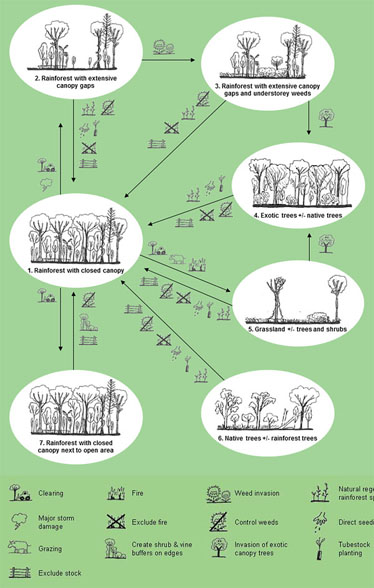
An ecological model for wet rainforest in Queensland (View larger version)
Depending on its management history, land that once supported rainforest may now support the same vegetation, fewer or no trees, a different vegetation type, or no trees at all. These are different condition states for rainforest.
The 2 ecological models shown on this page describe the different condition states for wet rainforest and dry rainforest, and what led to their formation. They also show how each state can be restored back to the ‘mature rainforest’ state (state 1), which is the maximum carbon state.
Wet rainforest
The main points of the ecological model for wet rainforest are:
- A major disturbance (e.g. tree clearing, cyclone damage) can reduce carbon stocks and create large canopy gaps allowing weed invasion to occur (states 1 to 3).
- Clearing followed by grazing can transform rainforest to a grassland or open woodland (state 5).
- Establishment of a canopy dominated by exotic trees (e.g. camphor laurel; state 4) or Acacia species (state 6) can slow the growth of rainforest plants.
- Creating open areas alongside rainforest patches can lead to weed invasion of the rainforest edges (state 7).
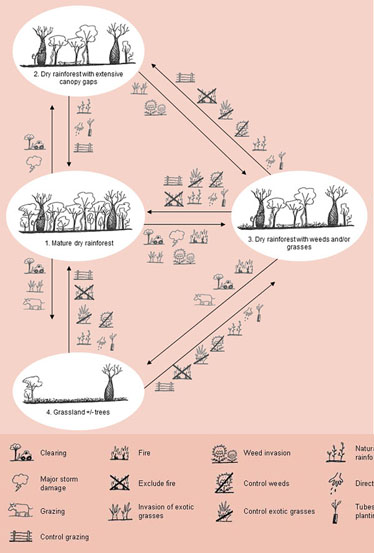
An ecological model for dry rainforest in Queensland (View larger version)
Dry rainforest
The main points of the ecological model for dry rainforest are:
- A major disturbance (e.g. tree clearing, cyclone damage) can reduce carbon stocks and create large canopy gaps (state 2).
- Weed invasion can occur with or without disturbance (state 3), as undisturbed dry rainforest tends to have a more open canopy than undisturbed wet rainforest.
- Invasion of flammable weed species (e.g. lantana) can increase the risk of fire (states 3 to 4).
- Clearing followed by grazing can transform rainforest to a grassland or open woodland (state 4).
For both rainforest types, the most rapid increase in carbon stocks for state 2 will be achieved by hastening its development into a mature rainforest (state 1). This transition will be accelerated if there is no further disturbance (including fire), grazing or weed invasion, and if native vines are prevented from smothering trees.
Similar conditions will help to increase carbon stocks in the other states, however states without a rainforest tree seed source will require direct seeding or tubestock planting. Degraded states may also require weed control and soil rehabilitation.
Carbon stocks in a mature rainforest (state 1) will be maintained close to their capacity if there are low levels of disturbance (e.g. periodic tree fall, minor storm damage), but no clearing, grazing and/or hot fires.
Identify your site’s condition state
To identify the condition state of your site, answer the following questions.
Wet rainforest
- Is the tree canopy closed? (> 70% cover)?
- Yes—Go to question 2
- No—Go to question 3
- Do rainforest trees make up more than 80% of the tree canopy?
- Yes—Go to question 4
- No—Go to question 5
- Is the tree canopy cover more than 30%?
- Yes—Go to question 6
- No—You probably have grassland +/- trees and shrubs (state 5)
- Are weeds present in the understorey? Are exotic vines present?
- Yes—You probably have rainforest with closed canopy and weeds on edges (state 7)
- No—You probably have rainforest with closed canopy (state 1)
- Do exotic trees make up more than 30% of the tree canopy?
- Yes—You probably have exotic trees +/- native trees (state 4)
- No—You probably have native trees +/- rainforest trees (state 6)
- Do rainforest trees make up more than 80% of the tree canopy?
- Yes—Go to question 7
- No—Go to question 5
- Are weeds present in the understorey? Are exotic vines present?
- Yes—You probably have rainforest with extensive canopy gaps and understorey weeds (state 3)
- No—You probably have rainforest with extensive canopy gaps (state 2)
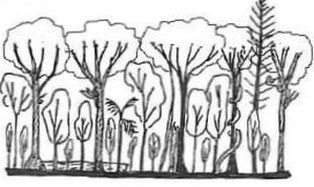
State 1—Rainforest with closed canopy
State 1—Rainforest with closed canopy
More than 70% canopy cover composed of more than 80% native rainforest species. Abundant and diverse seed supply. Ongoing recruitment of trees. Weeds in very low densities or absent. No bare ground.
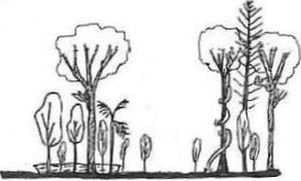
State 2—Rainforest with extensive canopy gaps
State 2—Rainforest with extensive canopy gaps
Less than 70% canopy cover composed of more than 80% native rainforest species. Diverse seed supply may be limited. Weeds in very low densities or absent. Bare ground may be present.
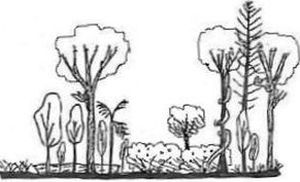
State 3—Rainforest with extensive canopy gaps and understorey weeds
State 3—Rainforest with extensive canopy gaps and understorey weeds
Less than 70% canopy cover composed of more than 80% native rainforest species. Diverse seed supply may be limited. Understorey weeds in medium to high densities. Bare ground may be present.
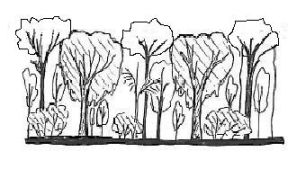
State 4—Exotic trees +/- native trees
State 4—Exotic trees +/- native trees
From 30% to 100% canopy cover, composed of more than 30% exotic trees. Diverse seed supply be limited. Bare ground may be present.
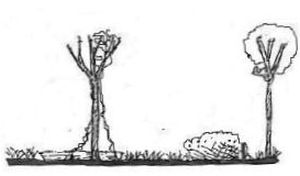
State 5—Grassland +/- trees and shrubs
State 5—Grassland +/- trees and shrubs
Less than 30% tree canopy cover composed of native or exotic species. Weeds (grasses, shrubs and vines) in medium to high densities. Diverse seed supply may be limited. Bare ground may be present.
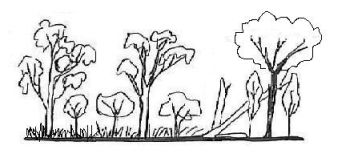
State 6—Native trees +/- rainforest trees
State 6—Native trees +/- rainforest trees
From 30% to 100% canopy cover composed of more than 50% non-rainforest native plant species (especially acacias). Diverse seed supply may be limited. Weeds and bare ground may be present.
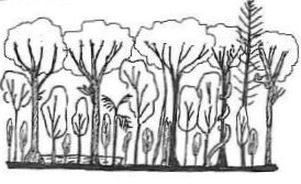
State 7—Rainforest with closed canopy adjacent to open area
State 7—Rainforest with closed canopy adjacent to open area
More than 70% canopy cover composed of more than 80% native rainforest species. Weeds present on edges or within patch. Diverse seed supply may be limited. No bare ground.
Dry rainforest
- Is the tree canopy cover more than 30%?
- Yes—Go to question 2
- No—You probably have grassland +/- trees (state 4)
- Are there extensive canopy gaps?
- Yes—You probably have rainforest with extensive canopy gaps (state 3)
- No–Go to question 3
- Are weeds and/or grasses in medium to high densities?
- Yes—You probably have rainforest with weeds and/or grasses (state 3)
- No—You probably have rainforest (state 1)
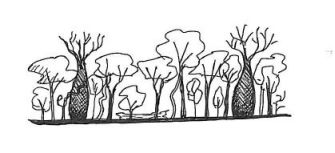
State 1—Rainforest
State 1—Rainforest
More than 30% canopy cover composed of more than 80% native dry rainforest species. Abundant and diverse seed supply. Ongoing recruitment of trees. Grasses and weeds in very low densities or absent. No bare ground.
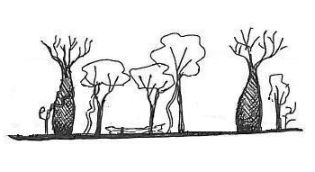
State 2—Rainforest with extensive canopy gaps
State 2—Rainforest with extensive canopy gaps
More than 30% canopy cover composed of more than 80% native dry rainforest species. Disturbance has caused extensive canopy gaps. Diverse seed supply may be limited. Bare ground may be present.
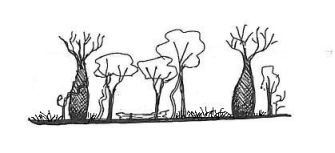
State 3—Rainforest with weeds and/or grasses
State 3—Rainforest with weeds and/or grasses
More than 30% canopy cover composed of more than 80% native dry rainforest species. Diverse seed supply may be limited. Weeds and/or bulky grasses in medium to high densities. Bare ground may be present.
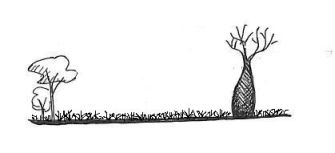
State 4—Grassland +/- trees
State 4—Grassland +/- trees
Less than 30% canopy cover composed of dry rainforest or other trees. Diverse seed supply may be limited. Weeds and/or bulky grasses in medium to high densities. Bare ground may be present.
Doesn’t seem to fit?
Check the vegetation of your site with the interactive map.
Wet rainforest—management issues
The main management issues for each condition state for wet rainforest are summarised below.
Condition states 3 and 7 have been grouped because their management issues are the same.
| Condition state | Description | Main management issue |
|---|---|---|
| 1 | Canopy closed; native rainforest trees present and dominating the canopy; weeds absent | Areas in this state should require little intervention to sustain or increase their carbon stocks (if recovering), although any weeds should be eradicated |
| 2 | Canopy with extensive gaps; native rainforest trees present and dominating the canopy; weeds absent | Areas in this state will require weed eradication, and may need minor supplementary planting |
| 3 and 7 | Canopy closed or with extensive gaps; native rainforest trees dominate the canopy; understorey weeds and/or exotic vines present in patch, and/or weeds present on edges | Weed management will be needed to maintain and increase carbon stocks |
| 4 | Canopy closed; exotic trees > 30% of canopy | You will need to remove exotic trees in stages to maintain and increase carbon stocks through the restoration of wet rainforest |
| 5 | Grassland; native rainforest trees may be present | It is critical to have seed sources for rainforest trees, and weed control during establishment, for restoration of carbon stocks from the grassland state |
| 6 | Canopy open or closed; native non-rainforest trees > 50% of canopy | Preventing fires and establishing rainforest trees will be needed to maintain and increase carbon stocks through the restoration of wet rainforest |
Dry rainforest—management issues
The main management issues for each condition state for dry rainforest are summarised below.
| Condition state | Description | Main management issue |
|---|---|---|
| 1 | Canopy > 30% or with extensive gaps; native rainforest trees present and dominating the canopy; weeds in low densities or absent | Areas in this state should require little intervention to sustain or increase their carbon stocks (if recovering), although weeds should be eradicated |
| 2 | Canopy with extensive gaps; native rainforest trees present and dominating the canopy; weeds in low densities or absent | Areas in this state may need minor supplementary planting, and will require weed eradication |
| 3 | Canopy > 30% or with extensive gaps; native rainforest trees present and dominating the canopy; weeds and/or bulky grasses in medium to high densities | Weed management and fire suppression will be needed to maintain and increase carbon stocks |
| 4 | Grassland; native rainforest trees may be present; weeds and/or bulky grasses in medium to high densities | Seed sources for rainforest trees, weed control, fire suppression, and watering during seedling establishment, will be critical to the restoration of carbon stocks from the grassland state |


